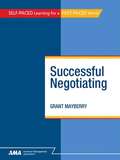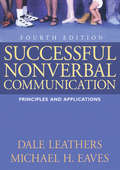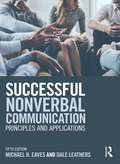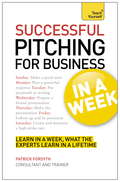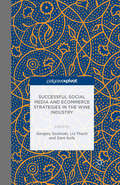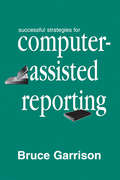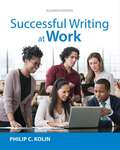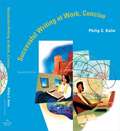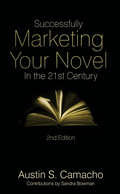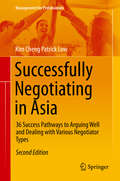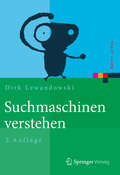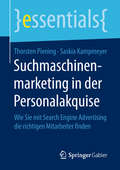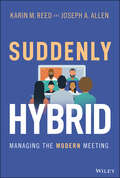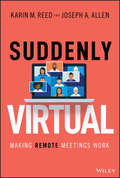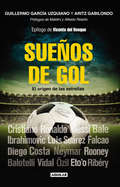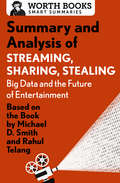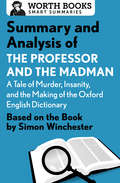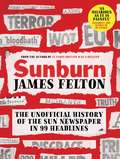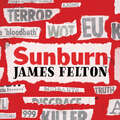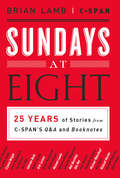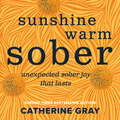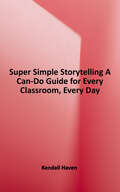- Table View
- List View
Successful Negotiating
by Grant MayberryHow to achieve positive outcomes using planning and conversational techniques. Very few of us are born negotiators. However, Successful Negotiating can teach you the art of win/win negotiation. You’ll get a firm grasp of the negotiating tricks and techniques the pros use. Learn everything from prenegotiation planning to the use of seemingly unimportant details like seating arrangements and meeting site selection to influence the results of negotiations. You will learn how to: • Sway an opponent with timing and association techniques • Identify an opponent's real but often hidden needs • Use questions to control the thrust of a discussion • Employ proven strategies like the "missing man," "straw issues," and "walkout" ploys • Communicate a position clearly and precisely • Plan a realistic course of action based on sound preparation and an objective appraisal of resources • Keep the negotiation process open to reasonableness and flexibility at all times • Draw on your own skills, experience, and self-discipline to keep the process moving in the direction you want
Successful Nonverbal Communication: Principles and Applications
by Michael Eaves Dale G. LeathersSuccessful Nonverbal Communication: Principles and Applications demonstrates how knowledge of nonverbal messages can affect successful communication in the real world. This extensive revision describes nonverbal cues and their desirable and non-desirable functions while offering original tests for measuring and developing nonverbal communication skills. This text draws students into the material through helpful applications of the latest nonverbal communication research and through current examples of celebrities, sports and politicians. Significant updates are found in the chapters on tactile communication, personal appearance, political debates, intercultural communication and virtual contexts. The highlight of this rewrite is the cutting-edge scholarship that is seamlessly interwoven throughout the text.
Successful Nonverbal Communication: Principles and Applications
by Michael Eaves Dale G. LeathersSuccessful Nonverbal Communication: Principles and Applications demonstrates how knowledge of nonverbal messages can affect successful communication in the real world. Now with fifteen chapters, the fifth edition draws students in through applications of the latest nonverbal communication research and through current examples of celebrities, sports, and politicians. This extensive revision describes nonverbal cues and their desirable and undesirable functions while offering original tests for measuring and developing nonverbal communication skills. Updates include new attention to Donald Trump, Hillary Clinton, and Barack Obama, and discussion of nonverbal communication within same-sex partnerships.
Successful Pitching For Business In A Week: Teach Yourself
by Patrick ForsythThe book focuses on the special nature of winning significant business in competitivemarkets in pitches involving several formal stages. It will: Review the essential processes of making complex sales and the role of coretechniques of persuasion Show how to handle initial contacts and meetings and obtain a clear brief regardingcustomer/client needs Demonstrate the process of analysing client needs and putting clear and persuasiveproposal documents in writingSunday: What is a pitch?Monday: Initial contactTuesday: Planning a powerful responseWednesday: Putting proposals in writingThursday: Preparing a formal presentational pitchFriday: Making the presentationSaturday: Follow-up action and the power of persistence
Successful Pitching For Business In A Week: Teach Yourself
by Patrick ForsythThe book focuses on the special nature of winning significant business in competitivemarkets in pitches involving several formal stages. It will: Review the essential processes of making complex sales and the role of coretechniques of persuasion Show how to handle initial contacts and meetings and obtain a clear brief regardingcustomer/client needs Demonstrate the process of analysing client needs and putting clear and persuasiveproposal documents in writingSunday: What is a pitch?Monday: Initial contactTuesday: Planning a powerful responseWednesday: Putting proposals in writingThursday: Preparing a formal presentational pitchFriday: Making the presentationSaturday: Follow-up action and the power of persistence
Successful Social Media and Ecommerce Strategies in the Wine Industry
by Liz Thach Dani Kolb Gergely SznolnokiThis book focuses on principles and practices in digital wine marketing. By providing a global overview of social media and e-commerce strategies and practices in the wine business, this book allows readers to understand how consumers and producers deal with these modern communication and selling platforms.
Successful Strategies for Computer-assisted Reporting (Routledge Communication Series)
by Bruce GarrisonComputers have changed the landscape of both gathering and disseminating information throughout the world. As journalists quickly move toward the 21st century and perhaps, a new era of electronic journalism, resources are needed to understand the newest and most successful computer-based news reporting strategies. Written to serve that purpose, this book is designed to show both professional journalists and students which of the newest personal computing tools are being used by the nation's leading news organizations and top individual journalists. It further describes how these resources are being used on a daily basis and for special projects. In recent years, computers have taken on new and dominating roles in the process of news analysis, newsgathering, and news processing. Today's forward-thinking journalists often seek guidance over what they can do to strengthen their ability to be society's information processors and managers. This volume focuses upon how successful journalists are using computers through a major national computer-assisted reporting (CAR) study of daily newspapers. The study included two national surveys and a series of personal interviews with many of the nation's leading CAR specialists. Several current examples of stories used for successful database- and online-oriented news assignments are provided as part of a series of case studies incorporated throughout the book. The additional depth of description and the presentation of portions of stories themselves should help readers to understand the complete process involving CAR-oriented journalism. Substantial analytical detail is used to discuss the extent of computer use in newsrooms, computer training, CAR projects, CAR in daily reporting, hardware and software most commonly used, levels and types of online services used in news research, and portable hardware and software. The book concludes with the author's assessment of the effects and impact of personal computing in the newsroom and the future of personal computer applications in newsgathering. Explaining and defining advanced applications or terminology for readers, the approach to the book assumes a minimal familiarity with computers, but no advanced knowledge of computer operation.
Successful Writing At Work (with 2016 MLA Update Card, Eleventh Edition)
by Philip KolinSUCCESSFUL WRITING AT WORK, 11th Edition, is a comprehensive introduction to workplace writing with real-world examples and problems; an easy-to-read style; and thorough guidelines for planning, drafting, revising, editing, formatting, and producing professional documents in the global workplace. After a discussion of the writing process and collaboration, the author explores basic business communications (including e-communications and social media), letters, resumes, and other job search materials; proceeds to how to conduct research and document sources; and ends with guidance on more advanced tasks such as preparing visuals, websites, instructions, procedures, proposals, short and long reports, and presentations. You will learn how to be an effective problem solver at work, understand and write for a global audience, write clear and effective sentences, paragraphs, and documents, and select the best communication technologies to accomplish your goals. Each student text is packaged with a free Cengage Essential Reference Card to the MLA HANDBOOK, Eighth Edition.
Successful Writing and Speaking: The Communication Collection (9 Books)
by Bryan A. Garner Nancy Duarte Harvard Business Review Holly Weeks Jeff WeissThis Harvard Business Review digital collection will give you the confidence and tools you need to write and speak successfully. It includes the HBR Guide to Persuasive Presentations, by presentation expert Nancy Duarte; the HBR Guide to Better Business Writing, by writing expert Bryan A. Garner; the HBR Guide to Negotiating, by negotiation expert Jeff Weiss; Failure to Communicate, by consultant and coach Holly Weeks; as well as HBR's 10 Must Reads on Communication, Giving Effective Feedback, Running Meetings, How to Run a Meeting, and Managing Difficult Interactions.
Successful Writing at Work (Concise Edition)
by Philip C. KolinThis user-friendly, compact text presents the most necessary, useful skills and strategies for successful workplace writing. Based on the successful parent text, Successful Writing at Work, 8/e, the Concise Edition maintains a practical approach, an abundance of realistic situations and problems, real-world examples, and detailed guidelines for drafting, editing, and producing professional documents and graphics. The Second Edition features a contemporary, open, and user-friendly design, including a wider trim size to allow for marginal note-taking and many new and up-to-date visuals.
Successfully Marketing Your Novel in the 21st Century
by Austin Camacho Sandra BowmanThe rise of e-books, loss of bookstores, disappearance of the big publishers' midlists, improvements in self-publishing technology and the advent of social media have turned the book business on its head. One thing has remained the same. Novels must be promoted and marketed if an audience is to find them. Although it has never been easier to get a book published, it has also never been harder to get a book sold. Providing guidelines on how to drive book sales to a whole new level, this up-to-date book is crammed with tips and tricks of the book trade gathered from the authors' own experiences as an author.
Successfully Negotiating in Asia: 36 Success Pathways to Arguing Well and Dealing with Various Negotiator Types (Management for Professionals)
by Kim Cheng LowSuccessful negotiation requires understanding your counterpart’s culture, their feelings, habits and values. When planning to do business with suppliers and other partners in Asia, thorough preparation is essential in order to avoid misunderstandings, confrontations and disappointments, and to ensure the mutually desired success. This book offers a comprehensive guide to communication, argumentation, and negotiation by demonstrating success pathways with a focus on specific types of negotiator or negotiation partner from the different regions of the Asian continent. Readers will learn to negotiate the Chinese, the Indian and the Japanese way, and come to understand how Asians approach negotiations. Written by a truly international author, both academic and practitioner, with extensive experience in both Eastern and Western cultures, this book offers a valuable resource for anyone who relies on successfully negotiating with Asian partners.
Suchmaschinen verstehen (Xpert. Press Ser.)
by Dirk LewandowskiSuchmaschinen sind heute die wichtigsten Werkzeuge, um an Informationen zu gelangen. Wir verwenden Suchmaschinen täglich, meist ohne weiter darüber nachzudenken. Doch wie funktionieren diese Suchwerkzeuge eigentlich genau? Das Buch betrachtet Suchmaschinen aus vier Perspektiven: Technik, Nutzung, Recherche und gesellschaftliche Bedeutung. Es bietet eine klar strukturierte und verständliche Einführung in die Thematik. Zahlreiche Abbildungen erlauben eine schnelle Erfassung des Stoffs.Neben einer ausführlichen Darstellung der in den bekannten Suchmaschinen verwendeten Rankingverfahren wird auch ausführlich auf das Nutzerverhalten eingegangen, das wiederum die Ergebnisdarstellung prägt. Dazu kommen grundlegende Betrachtungen des Suchmaschinenmarktes, der Bedeutung der Suchmaschinenoptimierung und der Rolle der Suchmaschinen als technische Informationsvermittler. Das Buch richtet sich an alle, die mit Suchmaschinen zu tun haben und ein umfassendes Verständnis dieser Suchwerkzeuge erlangen wollen, u.a. Suchmaschinenoptimierer, Entwickler, Informationswissenschaftler, Bibliothekare, Rechercheure in Wissenschaft und Praxis sowie Online-Marketing-Verantwortliche.Für die zweite Auflage wurde der Text vollständig überarbeitet. Neben einem neuen Kapitel zur Suchmaschinenwerbung wurden zahlreiche Abschnitte zu neu aufgekommenen Themen hinzugefügt. Alle Statistiken und Quellen wurden auf den neuesten Stand gebracht.Aus Rezensionen zur ersten Auflage:„Dirk Lewandowski bringt den Fachleuten und Laien näher, was im Hintergrund der Suchmaschine abläuft und wie die Suchergebnisse zustande kommen.“ (Stephan Holländer in Password) „Dirk Lewandowski [...] hat einerseits das Fachwissen, sowohl in die Tiefe zu gehen als auch die Zusammenhänge so verständlich wie möglich zu behandeln. Ein Glücksfall!“ (Jürgen Plieninger in BuB)
Suchmaschinenmarketing in der Personalakquise: Wie Sie mit Search Engine Advertising die richtigen Mitarbeiter finden (essentials)
by Thorsten Piening Saskia KampmeyerThorsten Piening und Saskia Kampmeyer zeigen in diesem essential kompakt und auf den Punkt gebracht, wie Unternehmen im Internet neue Mitarbeiter gewinnen und insbesondere Search Engine Advertising (SEA) zielführend dafür nutzen können. Die Autoren erklären, wie Google und Co. die Candidate Journey effektiv unterstützen können und wie wichtig das kontinuierliche Monitoring mit allen Kennzahlen ist. Angereichert ist das essential mit zahlreichen praktischen Beispielen und konkreten Handlungsempfehlungen.
Suddenly Hybrid: Managing the Modern Meeting
by Joseph A. Allen Karin M. ReedDiscover the challenges and opportunities of hybrid meetings with this science-based guide from an Emmy-award winning communications expert and renowned organizational psychologist As remote work becomes less of an unusual exception and more of an everyday necessity, hybrid meetings—meetings in which some attendees are physically present while others are virtually present—are becoming the norm. In Suddenly Hybrid: Managing the Modern Meeting, Emmy award-winning communications expert Karin Reed and veteran industrial and organizational psychologist Dr. Joseph A. Allen deliver a practical and actionable framework for attending, hosting, and managing hybrid meetings. The authors draw from their extensive experience in research and business, as well as firsthand stories and up-to-date studies, to offer a guide that’s grounded in science and proven in the real world. You’ll learn about: Best practices based on research from the height of the pandemic and the unexpected paradigm shifts that resulted The challenges and opportunities presented by the trend towards hybrid meetings New research insights gathered from those early in the transition to hybrid meetings, as well as those who are well on their way to implementing a complete framework Perfect for senior business leaders, managers, and even individual contributors, Suddenly Hybrid: Managing the Modern Meeting is required reading for anyone expected to organize, host, or attend virtual or hybrid meetings in their workplace or school.
Suddenly Virtual: Making Remote Meetings Work
by Joseph A. Allen Karin M. ReedSupercharge your virtual meetings with evidence-based practices from an award-winning team The shift to virtual meetings was sudden and often traumatic for businesses across all industries as they responded to the global pandemic. Rather than focusing on what worked best, they focused on what worked now . . . which meant closing up the office and being suddenly virtual in nearly every meeting, often without the tools, the training, or the expertise to optimize the new “kitchen table” office. Thankfully, businesses are beginning to be more purposeful in both the tools they use and the approach they take. This book seeks to be a definitive guide for businesses looking to make their meetings as effective as possible in the ever-evolving “new normal”—leveraging insights from some of the foremost thought leaders in meeting science and on-camera communication. This book will: · Highlight new research insights springing from the rapid and exponential adoption of virtual meeting technology · Discuss the problems, challenges, and pitfalls of meeting in this new modality · Provide practical, actionable best practices, backed by meeting research that lead to more productive and effective virtual meetings Perfect for executives, managers, and employees at companies in all industries and of all sizes, Suddenly Virtual provides practical and actionable best practices that lead to more productive and effective remote meetings.
Sueños de gol: El origen de las estrellas
by Aritz Gabilondo Guillermo García Uzquiano<P><P>¿Cuánto cuesta un sueño? Catorce historias que dan testimonio vivo de que detrás de todo ganador hay un luchador lleno de grandes sueños. Con prólogos de Maldini y Relaño y epílogo de Vicente del Bosque. Con once años a Leo Messi le diagnosticaron una deficiencia de la hormona del crecimiento. Cristiano Ronaldo tuvo que afrontar muy joven la temprana muerte de su padre. Cuando era solo un bebé de cuatro meses, Neymar fue víctima de un grave accidente de coche. <P><P>El adolescente Falcao se refugió en la fe y en la Iglesia evangelista para superar una grave lesión. Balotelli fue adoptado por una familia de Brescia y renegaba del color de su piel. Ibrahimovic creció en un conflictivo gueto de Suecia. Diego Costa trabajaba en la frontera con Paraguay comprando productos electrónicos que luego revendía. Ribéry sufría burlas continuas por la cicatriz de su cara. La carrera de Luis Suárez fue salvada por el amor... <P><P>Estos y otros relatos conforman las catorce historias que dan testimonio vivo de que detrás de todo ganador hay un luchador lleno de grandes sueños. Desde una perspectiva tanto social como deportiva, los periodistas Guillermo García Uzquiano y Aritz Gabilondo bucean en los orígenes de las grandes estrellas del fútbol mundial y detallan todas las dificultades a las que se enfrentaron para llegar a ser lo que son hoy. Tenían un sueño. Y les costó alcanzarlo.
Summary and Analysis of Streaming, Sharing, Stealing: Big Data and the Future of Entertainment
by Worth BooksSo much to read, so little time? This brief overview of Streaming, Sharing, Stealing tells you what you need to know—before or after you read Michael D. Smith’s and Rahul Telang’s book. Crafted and edited with care, Worth Books set the standard for quality and give you the tools you need to be a well-informed reader. This short summary and analysis of Michael D. Smith and Rahul Telang’s Streaming, Sharing, Stealing includes: Historical context, Chapter-by-chapter summaries, Character profiles, Important quotes, Fascinating trivia, Glossary of terms, Supporting material to enhance your understanding of the original work. About Streaming, Sharing, Stealing by Michael D. Smith and Rahul Telang: There is a new world order in the entertainment industry. Digital technology has contributed to an explosion of content in the entertainment business as Netflix, Amazon, and Apple upend traditional entertainment, changing the way in which television, film, music, and books are made and consumed. In Streaming, Sharing, Stealing: Big Data and the Future of Entertainment, authors Smith and Telang document this massive change and demonstrate conclusively that making data-driven decisions and understanding customer behavior are the keys to the new marketplace. The summary and analysis in this ebook are intended to complement your reading experience and bring you closer to a great work of nonfiction.
Summary and Analysis of The Professor and the Madman: Based on the book by Simon Winchester
by Worth BooksSo much to read, so little time? This brief overview of The Professor and the Madman tells you what you need to know—before or after you read Simon Winchester’s book. Crafted and edited with care, Worth Books set the standard for quality and give you the tools you need to be a well-informed reader. This short summary and analysis of The Professor and the Madman by Simon Winchester includes:Historical contextChapter-by-chapter summariesDetailed timeline of key eventsImportant quotesFascinating triviaSupporting material to enhance your understanding of the original work About The Professor and the Madman by Simon Winchester: Simon Winchester’s The Professor and the Madman is the remarkable tale of two Victorian-era scholars, the English language, and the making of the Oxford English Dictionary. Recounting the unlikely bond between a criminally insane American Civil War veteran and the renowned Scottish editor of the OED, the enchanting story of their relationship illuminates the decades of the dictionary’s compilation—from A to Z. Wittily eloquent and historically incisive, The Professor and the Madman is the portrait of a friendship and, by extension, of the greatest dictionary ever created in the English language. The summary and analysis in this ebook are intended to complement your reading experience and bring you closer to a great work of nonfiction.
Sunburn: The unofficial history of the Sun newspaper in 99 headlines
by James Felton'An astonishing piece of work' James O'Brien'This book was a delight. Funny, scathing and witty' Ian Dunt You should buy this book if: a) you dislike the Sun, but have never actually read it to know why and/or b) you're still not sure how we got into this mess. Using his famed on-the-nose commentary, Twitter legend James Felton has dissected 99 of the most outlandish stories the Sun (for a long time the biggest-selling British newspaper) has run since it became a tabloid in 1969, hoping to answer once and for all whether the press has reflected - or manipulated - the British people over the last 50 years. Included: joke-riddled and illustrated analyses of the Sun's most infamous stories about celebrities, war, royals, crime, the LGBTQ+ community, migrants, the EU, politics, bacon sandwiches and page 3.Not included: A blindfold. We suggest reading through your fingers instead. 'James Felton makes me laugh like a bellend' Robert Webb'James Felton makes me laugh every day' Marina Hyde'James never fails to make me laugh and then think, then laugh some more' Dermot O'Leary
Sunburn: The unofficial history of the Sun newspaper in 99 headlines
by James Felton'An astonishing piece of work' James O'Brien'This book was a delight. Funny, scathing and witty' Ian Dunt You should buy this book if: a) you dislike the Sun, but have never actually read it to know why and/or b) you're still not sure how we got into this mess.Using his famed on-the-nose commentary, Twitter legend James Felton has dissected 99 of the most outlandish stories the Sun (for a long time the biggest-selling British newspaper) has run since it became a tabloid in 1969, hoping to answer once and for all whether the press has reflected - or manipulated - the British people over the last 50 years. Included: joke-riddled and illustrated analyses of the Sun's most infamous stories about celebrities, war, royals, crime, the LGBTQ+ community, migrants, the EU, politics, bacon sandwiches and page 3.Not included: A blindfold. We suggest reading through your fingers instead. 'James Felton makes me laugh like a bellend' Robert Webb'James Felton makes me laugh every day' Marina Hyde'James never fails to make me laugh and then think, then laugh some more' Dermot O'Leary
Sunburn: The unofficial history of the Sun newspaper in 99 headlines
by James FeltonJAMES FELTON'S "ASSHOLES" IS OUT NOW 'An astonishing piece of work' James O'Brien'This book was a delight. Funny, scathing and witty' Ian Dunt You should buy this book if: a) you dislike the Sun, but have never actually read it to know why and/or b) you're still not sure how we got into this mess. Using his famed on-the-nose commentary, Twitter legend James Felton has dissected 99 of the most outlandish stories the Sun (for a long time the biggest-selling British newspaper) has run since it became a tabloid in 1969, hoping to answer once and for all whether the press has reflected - or manipulated - the British people over the last 50 years. Included: joke-riddled and illustrated analyses of the Sun's most infamous stories about celebrities, war, royals, crime, the LGBTQ+ community, migrants, the EU, politics, bacon sandwiches and page 3.Not included: A blindfold. We suggest reading through your fingers instead. 'James Felton makes me laugh like a bellend' Robert Webb'James Felton makes me laugh every day' Marina Hyde'James never fails to make me laugh and then think, then laugh some more' Dermot O'Leary
Sundays at Eight: 25 Years of Stories from C-SPAN'S Q&A and Booknotes
by Brian Lamb C-SpanFor the last 25 years, Sunday nights at 8pm on C-SPAN has been appointment television for many Americans. During that time, host Brian Lamb has invited people to his Capitol Hill studio for hour-long conversations about contemporary society and history. In today's soundbite culture that hour remains one of television's last vestiges of in-depth, civil conversation.First came C-SPAN's Booknotes in 1989, which by the time it ended in December 2004, was the longest-running author-interview program in American broadcast history. Many of the most notable nonfiction authors of its era were featured over the course of 800 episodes, and the conversations became a defining hour for the network and for nonfiction writers.In January 2005, C-SPAN embarked on a new chapter with the launch of Q and A. Again one hour of uninterrupted conversation but the focus was expanded to include documentary film makers, entrepreneurs, social workers, political leaders and just about anyone with a story to tell.To mark this anniversary Lamb and his team at C-SPAN have assembled Sundays at Eight, a collection of the best unpublished interviews and stories from the last 25 years. Featured in this collection are historians like David McCullough, Ron Chernow and Robert Caro, reporters including April Witt, John Burns and Michael Weisskopf, and numerous others, including Christopher Hitchens, Brit Hume and Kenneth Feinberg.In a March 2001 Booknotes interview 60 Minutes creator Don Hewitt described the show's success this way: "All you have to do is tell me a story." This collection attests to the success of that principle, which has guided Lamb for decades. And his guests have not disappointed, from the dramatic escape of a lifelong resident of a North Korean prison camp, to the heavy price paid by one successful West Virginia businessman when he won $314 million in the lottery, or the heroic stories of recovery from the most horrific injuries in modern-day warfare. Told in the series' signature conversational manner, these stories come to life again on the page. Sundays at Eight is not merely a token for fans of C-SPAN's interview programs, but a collection of significant stories that have helped us understand the world for a quarter-century.
Sunshine Warm Sober: The unexpected joy of being sober – forever (The Unexpected Joy #5)
by Catherine Gray'Stone cold sober.'Sounds horrible, doesn't it? Hard, icy. Brrrrr. No bloody ta.However, as the millions who choose to stay sober now know, the propaganda around drinking and sobriety is wonky. Sober doesn't feel stony, or cold.Retired wreckhead Catherine Gray, author of surprise bestseller The Unexpected Joy of Being Sober, is now in her ninth sober year and has learnt a damn sight more.This hotly anticipated sequel enlists the help of experts and case studies, turning a curious, playful gaze onto provocative questions. Is alcohol a parenting aid? Why are booze and cocaine such a horse and carriage? Once an addict, always an addict? How do you feel safe - from alcohol, others and yourself - in sobriety?Whether you're a dedicated boozehound, flirting with teetotalling, or already sober, this witty, gritty read may just change how you think about alcohol forever. Praise for The Unexpected Joy of Being Sober:'Fascinating' - Bryony Gordon'Truthful, modern and real' - Stylist'Brave, witty and brilliantly written' - Marie Claire'Gray's tale of going sober is uplifting and inspiring' - The Evening Standard'Not remotely preachy' - The Times'Jaunty, shrewd and convincing' - The Telegraph'Admirably honest, light, bubbly and remarkably rarely annoying' - The Guardian'An empathetic, warm and hilarious tale from a hugely likeable human' - The Lancet Psychiatry(p) 2021 Octopus Publishing Group
Super Simple Storytelling: A Can-Do Guide for Every Classroom, Every Day
by Kendall HavenDesigned for educators and other professionals who want to improve communication skills and boost learning, these simple storytelling techniques are as fun as they are effective. Haven's breakthrough approach helps you build on your natural storytelling abilities to refine your communication skills in the classroom, library, and even at home. This book has everything you need to get started, including detailed directions and guides for more than 40 powerful storytelling exercises to use with your class. You'll find the Golden List of what an audience needs from storytelling, a proven, step-by-step system for successfully learning and remembering a story, the Great-Amazing-Never-Fail Safety Net to prevent storytelling disasters, a comprehensive discussion of the proven value of storytelling in education, and more. The book also shows you how to effectively use storytelling across the curriculum to capture student interest and boost learning.
